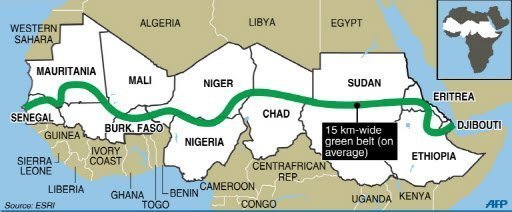As highlighted in my previous blogpost, drainage systems in most of Nigerian cities are bedeviled by multiple problems making them predominantly nonfunctional. This is seriously alarming in the light of the projected increase in the frequency of flood events across Africa. We may not have control over natural disasters, but we can mitigate their effects by adopting appropriate strategies that reduce our vulnerability and fortress our coping mechanisms.
In order to achieve that, a long term plan towards sustainable and efficient urban management needs to be devised. The failure of the current traditional drainage systems may in fact be as a result of its incompatibility with modern development. It is, therefore, imperative for urban planners to come up with creative solutions suitable for Nigerian cities. We can learn from similar techniques developed in other parts of the world that have proven to be successful. I will highlight here two such approaches that have been named as Sustainable Drainage System (SuDS) and Water Sensitive Urban Design (WSUD).

Sustainable drainage system
The system was first introduced in the United Kingdom in order to address the inefficacy of the traditional drainages. It is an alternative drainage system mainly developed to accommodate flow dynamics due to rapid urbanization. Traditional drainage systems are designed to drain runoff quickly through surface ditches or underground pipes. The biggest challenge to this approach is the inability of the system to cope with unforeseen variation in flow dynamics such as that caused by land development and unprecedented intense rainfall. Since the replacement or expansion of the existing drains would be a complicated task, SUDS incorporate brilliant water management measures into the system.
Instead of treating rainwater as a burden to be gotten rid of, SUDS technique prioritizes its capture, utilization, and absorption. Basically, the rainfall is ensured to be mostly dealt with at the location it fell. The techniques include permeable pavements, swales, green roofs, rainwater harvesting, infiltration trenches, and wetlands. Selection of which of these to be included is made based on the feasibility report from the area being designed.In addition to flood mitigations, SUDS come with other additional benefits. Some of the features mentioned facilitate the recharge of both shallow and groundwater thereby reducing the risk of drought. The system also improves vegetation growth and provides water bodies for birds and other animals to thrive. It also plays an important role in controlling surface and groundwater pollution. SUDS is indeed strong adaptive strategy against the current environmental and ecological challenges we are facing.

In addition to flood mitigations, SUDS come with other additional benefits. Some of the features mentioned facilitate the recharge of both shallow and groundwater thereby reducing the risk of drought. The system also improves vegetation growth and provides water bodies for birds and other animals to thrive. It also plays an important role in controlling surface and groundwater pollution. SUDS is indeed strong adaptive strategy against the current environmental and ecological challenges we are facing.
Water sensitive urban design
Water Sensitive Urban Design was developed by Australian urban planners with the purpose of making urban landscapes sensitive to the natural water cycle. Similar to SUDS, it also treats stormwater as a valuable resource that can benefit the community and all sort of biodiversity in the urban environment. The design approach considers flood risk management, sustainable water supply and use, as well as improvement of water quality in reservoirs to be interrelated.
Under this system, buildings are equipped with water-efficient appliances and landscape to lower down potable water demand and consumption. Wastewater treatment is also localized and recycled whenever possible. As in the case of SUDS, permeable pavements are introduced to facilitate infiltration and storage facilities installed for water harvesting. Bio-retention swales, sand filters, and infiltration trenches are also incorporated for removal of sediments and other solids. The whole setup ensures that only small portion of runoff ends up in the drains.
Contextualizing the engineering
Considering that the drainage systems in many of Nigerian cities are in dire need of rehabilitation, responsible authorities should make sustainable water management a priority. Even where the traditional drainages are in good shape, retrofitting them with an environment friendly system and ensuring that new development follow a sustainable approach would pay back in the long run. That would bring many benefits to the community and make the environment safer and healthier (a.k.a. greener).
Some elements of the sustainable management practice would have a significant and an immediate impact. Take for example the portable water management and rainwater harvesting technique. With many households across some of Nigerian cities not getting constant water supply and others having to deal with costly bills, sustainable water management would be a great relief. Actually, citizens do not have to wait for the government to re-plan the cities before adopting simple and beneficial technologies for water use reduction and personal rainwater storage. Communities can also collaborate in order to install large water retention systems that may prove useful on dry days.
While the existing drainages reign
It is our collective responsibility to ensure that our current drainage networks work to their designed capacity. Indiscriminate waste disposal into waterways cannot continue while we live in fear of flash flood whenever a heavy rain is forecast. Governments and communities need to work together to provide and abide by designated garbage collection areas. Citizen’s attitude of throwing away trash in the open space needs to change. Agencies responsible for the maintenance of the infrastructure should also be organizing routine sedimentation cleaning for all drains.
On a final note, it is important to remember that the future of our habitat depends on our actions today. Policy makers should incorporate environmental sustainability in every new development to ensure that our cities are able to cope with the increasing pressure. Individuals should also learn to adopt sustainable living practices at home and places of work.
[blog_subscription_form]
Written by Sada.
 Sada Haruna is the IT strategist at Green Habitat and a contributor to the blog. He is a PhD student in the department of Environmental Engineering at the University of Ottawa. His current research focuses on safe disposal of toxic mine wastes and remains an ardent advocate of environmental sustainability. He enjoys reading and coding at his leisure time. Follow him on Twitter @H_Sadah
Sada Haruna is the IT strategist at Green Habitat and a contributor to the blog. He is a PhD student in the department of Environmental Engineering at the University of Ottawa. His current research focuses on safe disposal of toxic mine wastes and remains an ardent advocate of environmental sustainability. He enjoys reading and coding at his leisure time. Follow him on Twitter @H_Sadah


Thanks Sadah for your coverage of urban stormwater issues in Nigeria. Like you I think SUDS is great for community initiatives, both involving locals in construction and ongoing maintenance – we could look on it as democratising infrastructure.